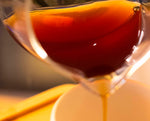Umami - Going deep into senses
| Back to Overview | Published: 21/11/17 | Duration: 3 min read |
As part of our satellite program for the last Berlin Coffee Festival, we at THE BARN designed a specialised sensory class. The idea for the workshop was based all around the concept of Umami. This included an informative background on the science and history behind it, matched with an interactive lesson on its presence in specialty coffee. As the tutor for this workshop, I wanted to explore it in greater depth. I teamed up with Robin Hoshino, our representative in Japan, that came over for BCF to join forces with me.
Exploring Flavour
We are obsessed with a great range of flavours, the sweetness and the acidity of the brew in our hands. But Umami was a taste that had not come up in much coffee conversation before. I had previously learned about this ‘meaty’ flavour and recognising it from my training with the Speciality Coffee Association, but had never learned much more about it after that. Umami is the scientifically recognised fifth basic flavour; along with sweet, sour/acidity, bitter and salty. It was only ‘acknowledged at the beginning of the 20th century, and is said to describe the ‘meaty’ or ‘savoury’ flavour that appears in, among other things, cooked meat, vegetables and cheese. Yet the focus of our Umami workshop was not just to taste it in food, but to recognise it in coffee, and the coffee that we serve. We chose a range of origins for the coffee we used, with a mixture of Kenyan, Ethiopian and South American beans. For us, it was an experiment to see where we could find it.
What We Learned
And the results were surprising. At the beginning of the course, we calibrated those attending that morning. Many were already seasoned coffee professionals, traveling from a range of different countries, while for others it was the first time they had ever heard of the concept of ‘cupping’. For recognising the flavours of umami, we slurped and reacted to basic water solutions of MSG. We then ate and smelled an assortment of foods, filling bowls with raw broccoli, beef jerky, Parmigiano-Reggiano flakes and tomatoes. We discussed our thoughts and observations throughout before moving onto our next part of the course, blind taste a range of coffees. While I had chosen an outside coffee that I felt would best represent Umami, it was another cup, a tomatoey-blackcurrant flavoured Kenyan, that the class agreed had those savoury qualities. They unanimously agreed that this coffee was a pleasant balance of sweetness, acidity and umami that left a long-lasting and desirable impression on them. In the end, both the tutors and the participants learned more about flavour that was to be expected, and is a concept we have been bringing more into our weekly sensory classes and on to the bar with customers. We’ll be running more focused sensory classes in the future.
You want to learn more about exploring different taste and flavours? Join our Sensory & Analysis Workshop

